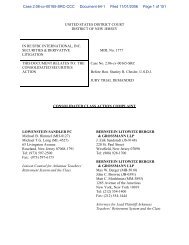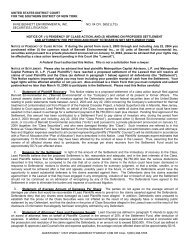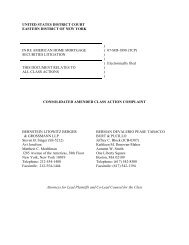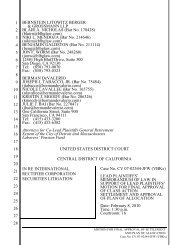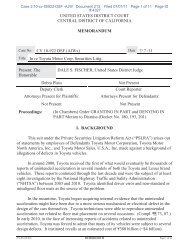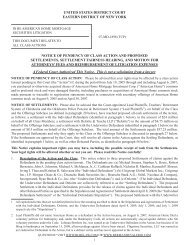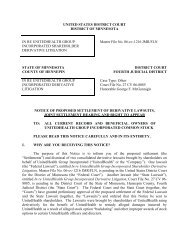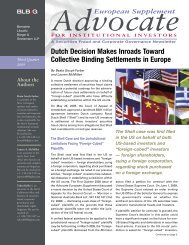to view the Lawdragon's - Bernstein Litowitz Berger & Grossmann LLP
to view the Lawdragon's - Bernstein Litowitz Berger & Grossmann LLP
to view the Lawdragon's - Bernstein Litowitz Berger & Grossmann LLP
Create successful ePaper yourself
Turn your PDF publications into a flip-book with our unique Google optimized e-Paper software.
500Lawdragon Q & A with:Jonathan StreeterbY John rYanIt’s always nice <strong>to</strong> go out – or at leastmake a career change – on <strong>to</strong>p, which defines <strong>the</strong>recent professional life of Jonathan Streeter. The newDechert partner was <strong>the</strong> government’s trial counselagainst Galleon Group head Raj Rajaratnam, <strong>the</strong> centerpieceof U.S. At<strong>to</strong>rney for <strong>the</strong> Sou<strong>the</strong>rn District ofNew York Preet Bharara’s highly publicized campaignagainst insider trading. Rajaratnam received an11-year sentence for netting tens of millions of dollarsfrom illegal trades.As an assistant U.S. at<strong>to</strong>rney, Streeter scored o<strong>the</strong>rhigh-profile trial vic<strong>to</strong>ries, including fraud convictionsagainst <strong>the</strong> former Duane Reade CEO and CFO, andagainst Ernst & Young partner James Gansman. Healso was <strong>the</strong> government’s lawyer in <strong>the</strong> case againstMarc Dreier, who <strong>to</strong>ok down his own firm (Dreier <strong>LLP</strong>)in an epic fake securites scheme that led <strong>to</strong> a guiltyplea and 20-year sentence.LAWDRAGon: Why did you make <strong>the</strong> move <strong>to</strong> privatepractice at this time?JonATHAn STREETER: I had an incredible job at <strong>the</strong>U.S. at<strong>to</strong>rney’s office, but I felt like I had done everythingI hoped <strong>to</strong> do <strong>the</strong>re – I was able <strong>to</strong> work on a lo<strong>to</strong>f great cases. I just felt like it was time for me <strong>to</strong>move on <strong>to</strong> <strong>the</strong> next challenge.LD: You must have had some options in terms of firmsthat would be interested. Why choose Dechert?JS: I was looking for a place that had two differentthings. Number one was an established practice in <strong>the</strong>space I want <strong>to</strong> work in, but number two was a kind ofentrepreneurial spirit – a place that wanted me <strong>to</strong>grow my own practice within <strong>the</strong> law firm. Dechert is<strong>the</strong> best of both of those worlds. They have what I doin white collar and securities litigation, but at <strong>the</strong>same time it’s a place where <strong>the</strong>y don’t just want me<strong>to</strong> show up and do <strong>the</strong> work that’s already <strong>the</strong>re. Theywant me <strong>to</strong> develop my own practice.LD: Do you think you will have any regrets leaving behinda job that was <strong>view</strong>ed as something of a public crusader?JS: Well, you know, it’s funny. A lot of criminal defenselawyers think that what <strong>the</strong>y are doing is just as importantas prosecu<strong>to</strong>rs because <strong>the</strong> government is anincredibly powerful force, and <strong>the</strong>re is a great benefit<strong>to</strong> <strong>the</strong> public in making sure <strong>the</strong> government is no<strong>to</strong>verstepping its bounds. It’s just as important as havingcapable people in <strong>the</strong> government. I can’t denythat for me an important part of working at <strong>the</strong> U.S.at<strong>to</strong>rney’s office was <strong>the</strong> public service part of it. But Idon’t feel any hesitation in what I do now. I had agreat run as a public servant, and I wouldn’t be surprisedif years from now I do something again in publicservice. But I don’t feel any hesitation in what I donow. There is a real social value <strong>to</strong> it.LD: Given <strong>the</strong> public’s anger at Wall Street, <strong>the</strong>reseemed <strong>to</strong> be a huge desire for a high-profile fraudconviction, as well as a tremendous amount of scrutinyof <strong>the</strong> Rajaratnam case. What was it like <strong>to</strong> have allthat pressure?JS: It was a thrill <strong>to</strong> have all <strong>the</strong> media attention on <strong>the</strong>case. I can’t deny that it was exciting <strong>to</strong> be able <strong>to</strong>read about your case in <strong>the</strong> newspaper every day. And Iwas certainly aware of its importance <strong>to</strong> <strong>the</strong> U.S. at<strong>to</strong>rney,that we win <strong>the</strong> case. The fact that <strong>the</strong>re was somuch media attention, it probably raised <strong>the</strong> stakescompared <strong>to</strong> if no one had been watching. But in a lo<strong>to</strong>f ways, we kind of blocked it out when we were in <strong>the</strong>courtroom and working on <strong>the</strong> trial. In terms of <strong>the</strong>day-<strong>to</strong>-day pressure, once we got going, I was sofocused on what I was doing, it didn’t alter my courtroomapproach <strong>to</strong> anything.LD: Media attention aside, what are <strong>the</strong> challenges ofbringing a complicated financial case like that <strong>to</strong> a jury?JS: Candidly, it was a little bit easier with this casebecause <strong>the</strong> facts, <strong>the</strong> characters and <strong>the</strong> evidencewere so interesting – we had <strong>the</strong> wiretaps, colorfulcharacters and witnesses who were prominent people.It was a little bit easier than in o<strong>the</strong>r financial fraudcases. But with financial fraud cases generally, youhave <strong>to</strong> take incredibly complicated subject matter andbreak it down in<strong>to</strong> simple parts. It’s doing that whilealso keeping <strong>the</strong> subject matter somewhat interestingfor <strong>the</strong> jury. You have <strong>to</strong> have a real understanding ofyour audience, what <strong>the</strong>y’re going <strong>to</strong> understand andnot understand, what you need <strong>to</strong> really explain andwhat you don’t need <strong>to</strong> explain.In <strong>the</strong> Rajaratnam case, we were constantly cuttingand simplifying our evidence. We had six cooperatingwitnesses and only put three on; we had thousands ofwiretap recordings and narrowed that down <strong>to</strong> 45 thatwe played; we had 40 s<strong>to</strong>ck transactions in play at <strong>the</strong>trial and used a little less than half in our case. Wekept cutting away <strong>to</strong> get <strong>to</strong> <strong>the</strong> core stuff that we absolutelyneeded <strong>to</strong> tell <strong>the</strong> s<strong>to</strong>ry. We put on <strong>the</strong> government’scase in about a month, and I was quite proud ofthat.See <strong>the</strong> full Q&A at www.lawdragon.com/lawyer-limelights/jonathan-streeter.L A W D R A G O N 110 I s s u e 13Pho<strong>to</strong> by: Laura Barisonzi



